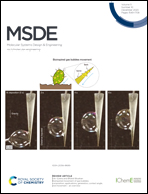Self-assembled blue-light emitting materials for their liquid crystalline and OLED applications: from a simple molecular design to supramolecular materials†
Abstract
This paper reports the first fluorescent supramolecular columnar liquid crystals derived from chalcone-biphenyl amine-functionalized on the lower rim of calixarene core with a good temperature range. The structural characterization and possible conformation of these supramolecular materials were studied by FT-IR, 1H NMR, 13C NMR and HRMS spectroscopic techniques. The photophysical and electrochemical properties were investigated by UV-visible spectrophotometry and cyclic voltammetry, respectively. All the synthesized materials (7a–7d) showed blue-light emission in solution, as well as in thin films, with good quantum yields. The number of peripheral alkoxy side chains substituted on the terminal position affected the thermal durability and stability of the calixarene derivatives. These supramolecules showed columnar self-assembly and stabilized mesophase with good thermal stability. The application of these chalcone ester-based supramolecular columnar liquid crystalline materials was tested by fabricating efficient blue organic light-emitting diodes (OLEDs) with either neat or doped materials.



 Please wait while we load your content...
Please wait while we load your content...